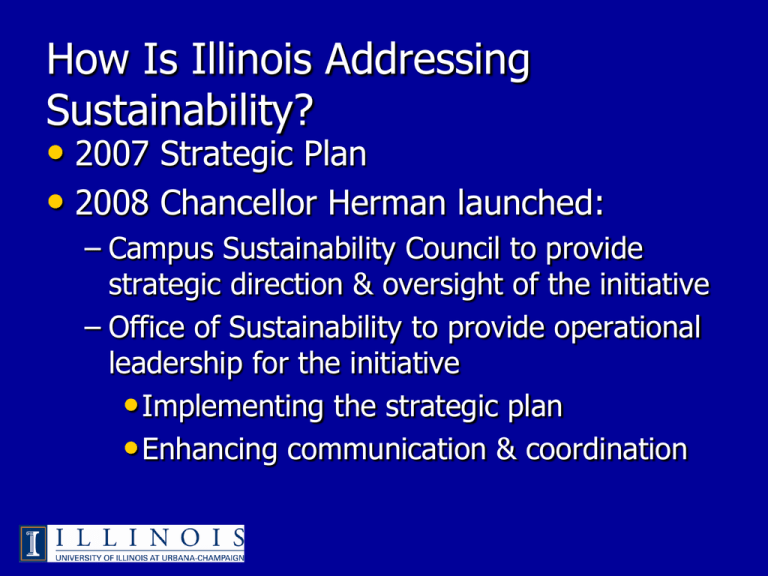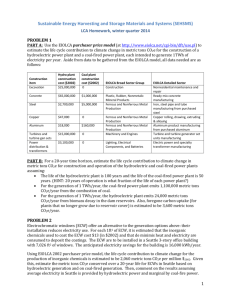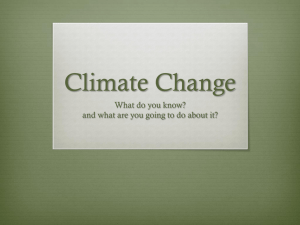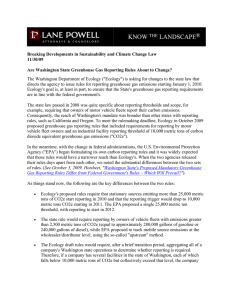How Is Illinois Addressing Sustainability? • 2007 Strategic Plan
advertisement

How Is Illinois Addressing Sustainability? • 2007 Strategic Plan • 2008 Chancellor Herman launched: – Campus Sustainability Council to provide strategic direction & oversight of the initiative – Office of Sustainability to provide operational leadership for the initiative • Implementing the strategic plan • Enhancing communication & coordination Office of Sustainability • Achieve responsibilities of the American College and University Presidents Climate Commitment including – Develop a comprehensive plan – Initiate action steps to reduce greenhouse gas emissions • Coordinate enhancement of campus infrastructure & • • • • policies Facilitate curricular enhancements, including service learning opportunities in the community Encourage innovative research collaborations Foster collaboration with external constituencies, especially our local communities Provide forums to promote meaningful dialogue on challenges and opportunities What is Sustainability?1 • Meeting the needs of the present without compromising the ability of future generations to meet their own needs. From Our Common Future: The Report of the World Commission on Environment and Development (“the Brundtland Commission report”) 1 The Strategic Opportunity in Global Sustainability Challenges: A Vision for Illinois Barbara Minsker, Associate Provost Fellow Dick Warner, Director, Office of Sustainability UIUC Grand Challenges Global Sustainability • Preserve natural ecosystems and create human- dominated ecosystems that mimic natural ecosystem services while providing essential human services. Our planet is becoming increasingly human dominated and our natural resources are being depleted and degraded beyond sustainable levels. • Sustainably raise the quality of life for the world’s poor to acceptable. Rapid population growth is leading to increasing pressures in providing basic services (e.g., food, water, education, health care) to sustain the world’s population. Illinois Sustainability Goals • Goal 1: Create a new forum for in-depth, cross• • • • disciplinary engagement on the sustainability grand challenges. Goal 2: Create and implement a sustainable campus operations plan that maintains or restores natural ecosystem function and supports impoverished communities. Goal 3: Infiltrate sustainable thinking into campus missions through new education activities. Goal 4: Create incentive programs that spur sustainability activities to meet the above goals. Goal 5: Create a viable financial plan for sustainability activities. Energy Conservation at Illinois • Campus consumption is now 9.8% lower than FY07 on a square foot basis. • Chancellor Herman's goals for the campus were a 10% reduction in three years, and a 20 to 25% reduction in ten years. We nearly achieved the 3 year goal in two. The FY09 energy reduction resulted in a budget savings of approximately $7.5 million. • The goal for FY10 is another 5% reduction (i.e. 5% below FY09). American College & University Presidents’ Climate Commitment (ACUPCC) ACUPCC institutions have agreed to: Complete an emissions inventory. Within two years, set a target date and interim milestones for becoming climate neutral. Take immediate steps to reduce greenhouse gas emissions by choosing from a list of shortterm actions. Integrate sustainability into the curriculum and make it part of the educational experience. Make the action plan, inventory and progress reports publicly available. 2008 GHG Report for University of Illinois at Urbana-Champaign HOME / GHG REPORT Submitted on May 14, 2009; last updated on May 14, 2009 Total Per Full-Time Enrollment Per 1000 Square Feet % Offset Gross emissions (Scopes 1 + 2) 491,258 metric tons of CO2e 11.7 metric tons of CO2e 24.4 metric tons of CO2e 0% Gross emissions (Scopes 1 + 2 + 3) 522,757 metric tons of CO2e 12.4 metric tons of CO2e 26 metric tons of CO2e 0% Net emissions 522,757 metric tons of CO2e 12.4 metric tons of CO2e 26 metric tons of CO2e N/A 2008 GHG Report for University of Illinois at Urbana-Champaign HOME / GHG REPORT Submitted on May 14, 2009; last updated on May 14, 2009 Scope 2 Emissions Purchased Electricity 109,143 metric tons of CO2e Purchased Heating 0 metric tons of CO2e Purchased Cooling 0 metric tons of CO2e Purchased Steam 0 metric tons of CO2e Total Scope 2 emissions 109,143 metric tons of CO2e 2008 GHG Report for University of Illinois at Urbana-Champaign HOME / GHG REPORT Submitted on May 14, 2009; last updated on May 14, 2009 Scope 3 Emissions Commuting 14,015 metric tons of CO2e Air Travel 17,484 metric tons of CO2e Solid Waste No information provided. Total Scope 3 emissions 31,499 metric tons of CO2e Climate Action for Some September 17, 2009 Higher Education News • The deadline for submission of climate action plans by close to 400 signatories of the ACUPCC came and went Tuesday with not even a quarter of those institutions submitting blueprints on time. • In all, just 88 of the 392 colleges and universities whose presidents signed the pledge back in 2007 filed their reports – the third set of documents required by the agreement -- by the end of the day on September 15. Climate Action for Some September 17, 2009 Higher Education News • The presidents of 650 colleges and universities -- representing a third of the U.S. student population -have signed the commitment and have staggered submission deadlines for initial profiles on their sustainability efforts, greenhouse gas inventories and climate action plans based on when they joined the initiative. Climate Action for Some September 17, 2009 Higher Education News • At some institutions that missed the deadline or asked for extensions, officials stressed their commitment to submitting climate action plans. Dave Newport, director of the Environmental Center at the University of Colorado at Boulder, has a staff of 50 working on sustainability issues, but still needs more time, not to formulate a plan but to get feedback from the campus and local communities. Why partner with Illinois? Corporate interests in the value proposition Policy, Law, and Government Biofuels Water Oil Power Grids Hydrogen Fuels Photovoltaics Fuel Cells and Batteries Nuclear Power Coal and Coal Power Engines Construction and HVAC Information Technology Education Biofuels at Illinois Corporate views of value proposition • Initiating an economically and environmentally sustainable biofuels industry without negative impacts on food production; • Ability to bring together biologists, agronomists, economists, lawyers, policy makers, and environmental scientists; • Systemic view of entire supply chain of biofuels and bioenergy systems (e.g., technical feasibility, economic validity, environmental sustainability, social-political acceptability, mechanics, coupling both upstream and downstream technologies); Corporate interest in biofuels at Illinois, continued • Photosynthesis research at molecular, biochemical, and whole-plant levels; • Research to assess impact of pests and plant pathogens on biomass production; • Engineering solutions for biomass production and use, i.e., developing enzymes to overcome biomass recalcitrance and engineering bacteria to improve biocatalysts of plant cell wall deconstruction Corporate interest in biofuels at Illinois, continued • Researching techniques for drought prediction and mitigation, as well as overall water quantity and quality in watersheds, which is important to biofuel production; • Validation of bench scale bioenergy-related technologies at the pilot scale level (e.g., production of butanol via fermentation); • Pioneering work in use of biofuels for efficient lowemissions diesel engines;



